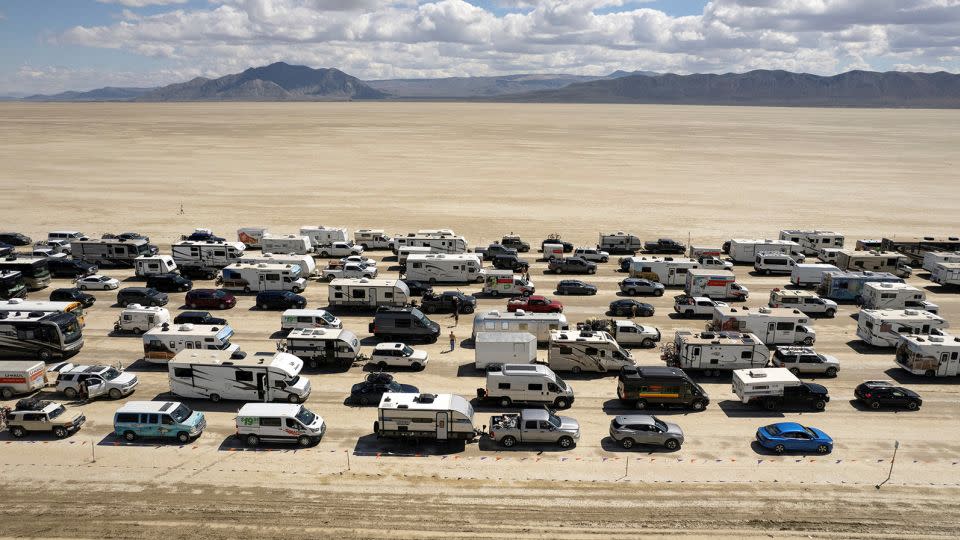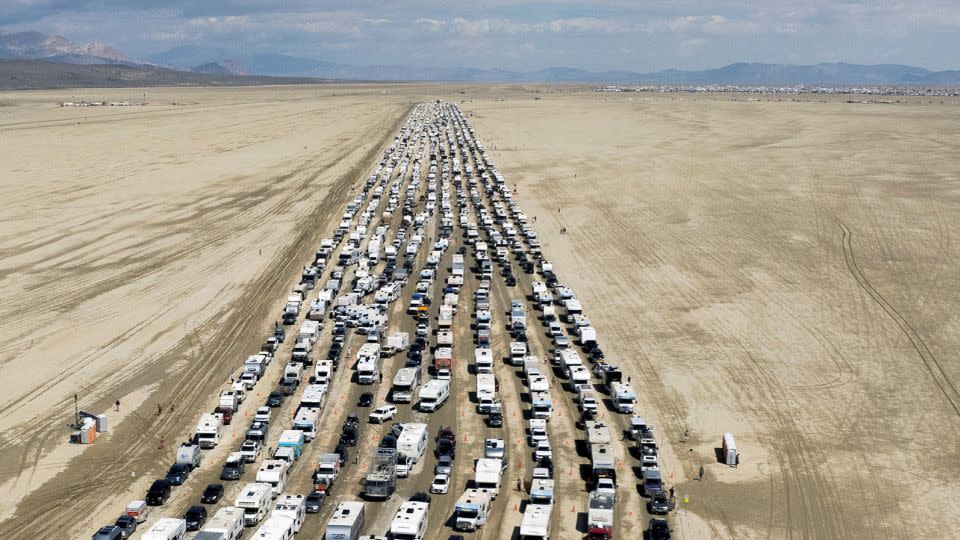Burning Man attendees make a mass exodus after a dramatic weekend that left thousands stuck in the Nevada desert
Thousands of Burning Man attendees finally made their mass exodus after intense rain over the weekend flooded camp sites and filled them with thick, ankle-deep mud – stranding more than 70,000 free-spirited revelers as they waited for the Nevada desert city to dry out.
Organizers officially announced the driving ban that was imposed amid heavy rains Friday had been lifted Monday afternoon, and attendees could safely leave Black Rock City, the makeshift city erected every year for the event.
The area was still muddy and parts were still difficult to navigate, organizers warned, and the wait time to leave the city Monday night was about seven hours. But that’s not unusual: It’s taken six to nine hours during peak travel times in past years, according to a Burning Man website.
By Tuesday morning, the situation had improved significantly:
“There is an estimated 2-3 hour wait to leave Black Rock City,” festival organizers posted on X, the platform formerly known as Twitter. “Everyone should get plenty of rest before starting to travel on the highway. Expect delay and be alert for debris from other vehicles on the highway at higher speeds. Travel Safe.”

For many attendees, getting stranded in the desert and missing flights and other responsibilities was stressful and unsettling. But some said the weather issues brought camp communities closer together, as people shared food and resources, offered shelter to those who needed it, and gathered together.
“As soon as the tents started getting water-logged or unlivable, people in RVs started taking in some of the tenters, so everybody was warm,” Kaz Qamruddin, who attended the event, told CNN’s Brianna Keilar Monday.
“We are a community that comes together in hard times,” he said, later adding, “It’s all about coming together and working as a team.”
Diplo, Cindy Crawford and other celebs navigate muddy desert
By the time officials lifted their travel ban, thousands of people had already left, some on foot, while others tested their luck in vehicles.
Among the early departures was music DJ Diplo, who told CNN he walked several miles in the muddy desert Saturday morning along with other celebrities, including Chris Rock, Cindy Crawford, Kaia Gerber and Austin Butler. When they reached the paved road, a fan offered them a ride in the back of a truck.
Of the 72,000 people who were still on site late Sunday evening, roughly 64,000 remained midday Monday, organizers said.
Many stayed, heeding officials’ recommendations, and waiting for the climax of the event: The burning of the Man.
One day later than scheduled, the massive wooden effigy known as the Man was set ablaze Monday night.

Why did the rain have such an impact on Burning Man?
After the first rains soaked campsites Friday, event leaders alerted attendees that driving was no longer allowed in the city. They halted entry and exit in the area, urged people to “shelter in place,” and conserve food and water.
The remote area in northwest Nevada was hit with up to 0.8 inches – about twice the average September rainfall – in just 24 hours between Friday and Saturday morning. And more rain followed Sunday.
“Quite a wet start to September for much of eastern CA-western NV,” the National Weather Service in Reno wrote on X. ” The heaviest rain fell in far eastern Churchill & Pershing counties, with totals close to 2.5”!”
Pershing County is where Burning Man takes place.
The reason why rain can have such an impact in an area like Black Rock City is because of its ground: the desert’s clay cannot absorb the water as quickly as loam, or more fertile soil.
“That water mixes in with that clay and it creates that cement, muddy mixture that people inevitably got stuck in,” CNN Weather Anchor Derek Van Dam said.
It’s why, even as some four-wheel drive vehicles successfully left over the weekend, many others got stuck on the muddy roads, making delays worse for others trying to leave.
Festival organizers sent out updates every couple hours throughout the weekend, continuing to urge attendees to stay put, stressing the need to keep roads clear and sharing weather forecasts. Finally, at 2 p.m. Monday, “the driving ban has been lifted,” they said in a post.
CNN’s Camila Bernal and Holly Yan contributed to this report.
For more CNN news and newsletters create an account at CNN.com

